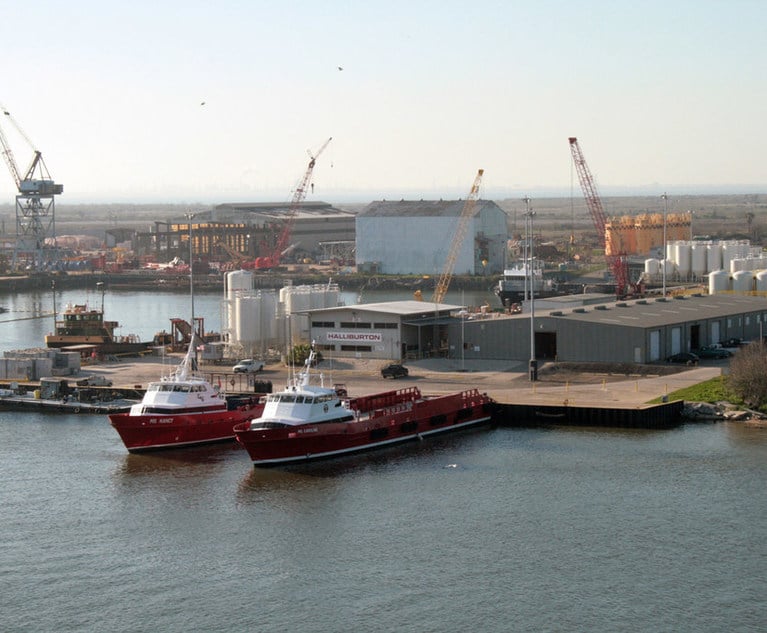See What Industry Ranks as Most Globally Corrupt
For general counsel and compliance officers, TRACE president and founder Alexandra Wrage said the industry holds "some of the greatest corruption risks, [and it] demands a heightened vigilance..."
March 18, 2020 at 04:50 PM
5 minute read
 Alexandra Wrage, president and founder of Annapolis, Maryland-based TRACE International. (Courtesy photo)
Alexandra Wrage, president and founder of Annapolis, Maryland-based TRACE International. (Courtesy photo)
Companies in the extractive industry faced the most bribery investigations in 2019, both by the U.S. and other global authorities, according to a new corruption report.
The 10th Annual Global Enforcement Report, released Thursday by TRACE International, shows these industries—which extract oil, diamonds, gold and other precious metals—were the target of 20% of all non-U.S. corruption investigations and 19% of all U.S. probes.
Alexandra Wrage, president and founder of Annapolis, Maryland-based TRACE, a nonprofit business association that works against bribery and corruption, called it the "resource curse."
Wrage told Corporate Counsel that extractive resources are by definition local, and access to them generally depends on a local government's authorization.
"At the same time, the potential for profit is enormous," Wrage said. "Combined with what is too commonly the political and institutional instability of resource-rich countries, these conditions create enormous incentives and opportunities for corruption."
For general counsel and compliance officers, she said the industry holds "some of the greatest corruption risks, [and it] demands a heightened vigilance" not just by the company but also on the part of governments, nongovernmental organizations and the media.
 (Photo: Trace International)
(Photo: Trace International)The problem is not new. From 1977 through 2019, the extractive industry represented the highest number of bribery enforcement actions, garnering about 18% of all U.S. actions and 25% of all non-U.S. enforcement actions.
"Whether we label the industry as corrupt generally, it's important to note that a lot of extraction industry companies are working hard to get this issue right and are at the forefront of innovative compliance efforts," Wrage said.
Although she declined to name leading companies, she said, "Industry best practices groups are getting more organized and more sophisticated. A group of mining companies is working to design a shared hotline, and some oil and gas companies are working collaboratively on an industry-specific shared 'best practices' training module."
Scot Anderson, global head of the energy and natural resources group at the Denver office of Hogan Lovells, said he has been working with the industry for decades and he agrees it is trying to set higher standards.
"I don't dispute that there may be a lot of investigations," Anderson said, "but I know the industry is working diligently. Setting aside the legal requirements, this [work] is more just based on doing the right thing and providing structures to help keep corrupt behavior [out of] mineral development."
He pointed to the efforts of the Extractive Industries Transparency Initiative to bring more openness to the countries and the industries involved. One of the group's most recent efforts involves seeking more transparency and due diligence around third party services and subcontractors, which account for the bulk of corruption enforcement actions. The industry spends nearly $1 trillion a year or more on procuring these goods and services.
Other industries also face legal scrutiny. In the U.S., the extraction industry was followed by financial services, with 16% of all investigations, and then manufacturers/service providers with 12%.
Outside the U.S., engineering/construction took second place with 18% of all investigations, and then aerospace/defense/security with about 15%.
Overall, Wrage said the report shows an unexpected 45% decrease in the number of non-U.S. enforcement actions generally. She couldn't explain why.
"It was only in January that we saw the record-breaking multinational settlement in the Airbus case," she said, "and worldwide concern over the issue of transnational corruption has remained high."
The U.S. also showed a slight decrease of 19% in enforcement actions, though the numbers were not out of line with historical trends.
Wrage speculated on a "clustering effect as global enforcement actions become more coordinated across jurisdictions, perhaps making any given year's numbers a bit more volatile. We'll have to keep an eye on the longer-term trends."
For general counsel and compliance officers, Wrage said the most important takeaway from the report is that reducing corruption "is a long-term effort to which the international community has remained largely committed in spite of global political turmoil. Aligning corporate values and actions to this anti-corruption agenda will help reinforce our collective stand in support of the rule of law in transnational affairs."
In other findings, the report shows:
- As of the end of 2019, Brazil was conducting the most investigations concerning alleged bribery of domestic officials by foreign companies, followed by India and China.
- China has had the highest prevalence of alleged bribery by foreign companies with 110 enforcement events since 1977.
- In total, there were 328 investigations concerning alleged bribery of foreign officials being conducted by authorities in 37 countries as of Dec. 31
- Europe was conducting 165 of the probes, or more than half. The U.S. was conducting about 37%, and the Asia Pacific region about 8%.
- Of companies based in the U.S. that were caught paying bribes, 34% of the payments went to Asian Pacific officials, 22% to the Americas, excluding the U.S., and 19% to Europe.
This content has been archived. It is available through our partners, LexisNexis® and Bloomberg Law.
To view this content, please continue to their sites.
Not a Lexis Subscriber?
Subscribe Now
Not a Bloomberg Law Subscriber?
Subscribe Now
NOT FOR REPRINT
© 2025 ALM Global, LLC, All Rights Reserved. Request academic re-use from www.copyright.com. All other uses, submit a request to [email protected]. For more information visit Asset & Logo Licensing.
You Might Like
View All
Top Coal Producer Hires General Counsel Who Previously Was Congressman, West Virginia Supreme Court Justice
2 minute read

Diamond Giant De Beers Appoints GC Amid Executive Shake-Up
Law Firms Mentioned
Trending Stories
- 1Uber Files RICO Suit Against Plaintiff-Side Firms Alleging Fraudulent Injury Claims
- 2The Law Firm Disrupted: Scrutinizing the Elephant More Than the Mouse
- 3Inherent Diminished Value Damages Unavailable to 3rd-Party Claimants, Court Says
- 4Pa. Defense Firm Sued by Client Over Ex-Eagles Player's $43.5M Med Mal Win
- 5Losses Mount at Morris Manning, but Departing Ex-Chair Stays Bullish About His Old Firm's Future
Who Got The Work
J. Brugh Lower of Gibbons has entered an appearance for industrial equipment supplier Devco Corporation in a pending trademark infringement lawsuit. The suit, accusing the defendant of selling knock-off Graco products, was filed Dec. 18 in New Jersey District Court by Rivkin Radler on behalf of Graco Inc. and Graco Minnesota. The case, assigned to U.S. District Judge Zahid N. Quraishi, is 3:24-cv-11294, Graco Inc. et al v. Devco Corporation.
Who Got The Work
Rebecca Maller-Stein and Kent A. Yalowitz of Arnold & Porter Kaye Scholer have entered their appearances for Hanaco Venture Capital and its executives, Lior Prosor and David Frankel, in a pending securities lawsuit. The action, filed on Dec. 24 in New York Southern District Court by Zell, Aron & Co. on behalf of Goldeneye Advisors, accuses the defendants of negligently and fraudulently managing the plaintiff's $1 million investment. The case, assigned to U.S. District Judge Vernon S. Broderick, is 1:24-cv-09918, Goldeneye Advisors, LLC v. Hanaco Venture Capital, Ltd. et al.
Who Got The Work
Attorneys from A&O Shearman has stepped in as defense counsel for Toronto-Dominion Bank and other defendants in a pending securities class action. The suit, filed Dec. 11 in New York Southern District Court by Bleichmar Fonti & Auld, accuses the defendants of concealing the bank's 'pervasive' deficiencies in regards to its compliance with the Bank Secrecy Act and the quality of its anti-money laundering controls. The case, assigned to U.S. District Judge Arun Subramanian, is 1:24-cv-09445, Gonzalez v. The Toronto-Dominion Bank et al.
Who Got The Work
Crown Castle International, a Pennsylvania company providing shared communications infrastructure, has turned to Luke D. Wolf of Gordon Rees Scully Mansukhani to fend off a pending breach-of-contract lawsuit. The court action, filed Nov. 25 in Michigan Eastern District Court by Hooper Hathaway PC on behalf of The Town Residences LLC, accuses Crown Castle of failing to transfer approximately $30,000 in utility payments from T-Mobile in breach of a roof-top lease and assignment agreement. The case, assigned to U.S. District Judge Susan K. Declercq, is 2:24-cv-13131, The Town Residences LLC v. T-Mobile US, Inc. et al.
Who Got The Work
Wilfred P. Coronato and Daniel M. Schwartz of McCarter & English have stepped in as defense counsel to Electrolux Home Products Inc. in a pending product liability lawsuit. The court action, filed Nov. 26 in New York Eastern District Court by Poulos Lopiccolo PC and Nagel Rice LLP on behalf of David Stern, alleges that the defendant's refrigerators’ drawers and shelving repeatedly break and fall apart within months after purchase. The case, assigned to U.S. District Judge Joan M. Azrack, is 2:24-cv-08204, Stern v. Electrolux Home Products, Inc.
Featured Firms
Law Offices of Gary Martin Hays & Associates, P.C.
(470) 294-1674
Law Offices of Mark E. Salomone
(857) 444-6468
Smith & Hassler
(713) 739-1250







